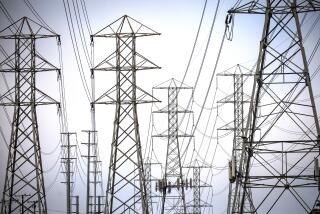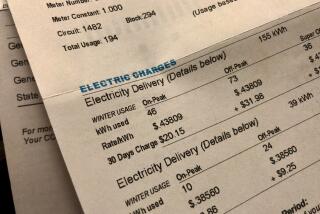How to Reduce Those Costly Utility Bills
- Share via
Low temperatures in December and January prompted Southland residents to use more gas and electricity than they normally do to heat their homes. And when the monthly bills arrived, there must have been some shocked homeowners.
All of which leads to the subject of insulation. Most of us would like to be paying less for energy but short of turning off lights and appliances, we don’t know how to go about it.
Actually, lighting and appliances account for a very small proportion of the energy used in most homes. Where is the energy used?
Heating and cooling account for 50% to 70%, while another 20% goes for heating water. Cutting down on heating and cooling has its limitations if family comfort is a consideration. So, what can be done?
Obviously, the answer is to improve the insulation in your home. According to the U.S. Department of Energy, most homes in the United States are not insulated to their best levels.
Older dwellings are more likely to have the drafts that mean high heating and air-conditioning bills. But even in new homes, adding insulation may save enough money in reduced utility bills to pay for itself in a few years, and then continue to save you money for as long as you own the home.
Insulation can be added to almost any house. Whenever structural framing is accessible, installation can be a do-it-yourself project. But whether you do it yourself or hire a contractor, it’s important to choose and install the insulation correctly.
What should be done first? Attics are important, including the hatch door or hatch cover. Provide the recommended level of insulation under floors, above unheated spaces and around walls in the basement, crawl spaces, foundation and on the edges of slabs-on-grade.
Consider exceeding the recommended levels of insulation for exterior walls of existing houses, particularly when remodeling or re-siding your house, or for new houses. See the drawing above for examples of where to insulate.
To begin, you need to know how much insulation you already have. A good way to find out is to have a complete energy audit made by a qualified auditor.
An insulation check is a routine part of an energy audit. Information about audits can be obtained from your local utility company.
Next, you need to determine how much more insulation would be cost-effective. First, check the attic, then check walls and floors next to unheated spaces like a garage or basement.
In an attic where the structural frame elements (the ceiling joists) are exposed, measure the depth or thickness of the insulation. It is more difficult to inspect finished exterior walls.
One method is to use an electrical outlet on the wall, but first be sure to turn off the power to the outlet. Then remove the cover plate and shine a flashlight into the opening to see how much, if any, insulation is in the wall.
An alternative method is to remove and then replace a small section of the exterior sheathing.
An indoor-outdoor exchange of about half of the house air volume every hour is needed to maintain an acceptable indoor air quality without controlled mechanical ventilation. Air exchange rates for pre-1973 houses are often more than this.
Higher rates can dramatically increase the amount of energy used for heating and cooling. Caulking and weatherstripping are effective ways to reduce air leakage.
Information about types of insulation can be obtained from your building supply store or utility company.
More to Read
Inside the business of entertainment
The Wide Shot brings you news, analysis and insights on everything from streaming wars to production — and what it all means for the future.
You may occasionally receive promotional content from the Los Angeles Times.










